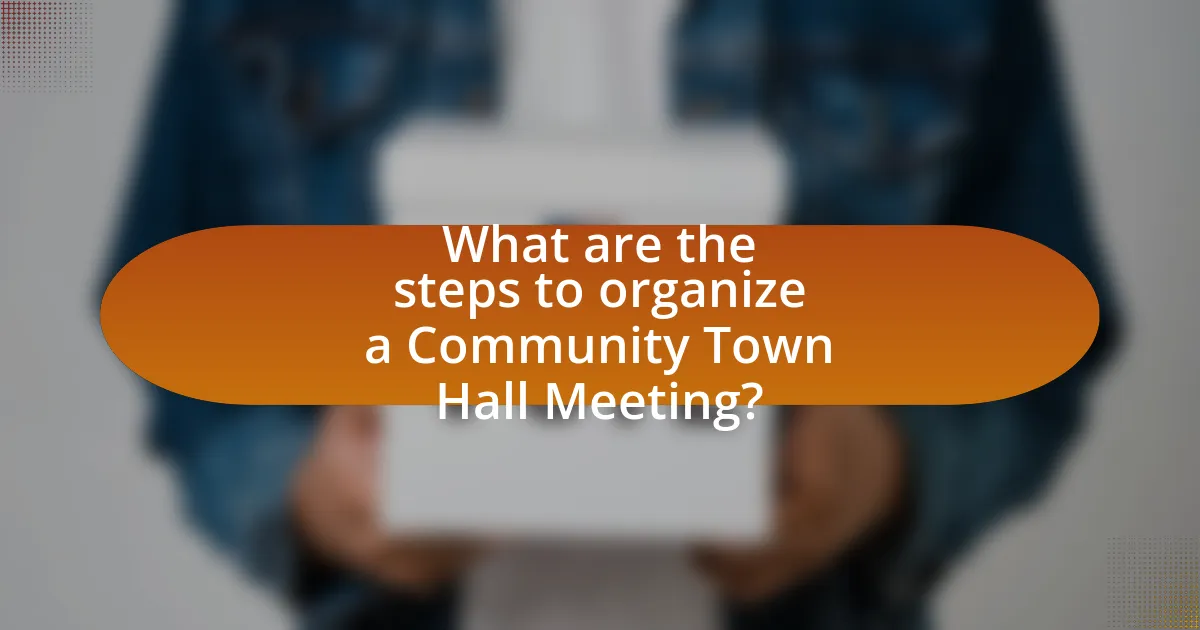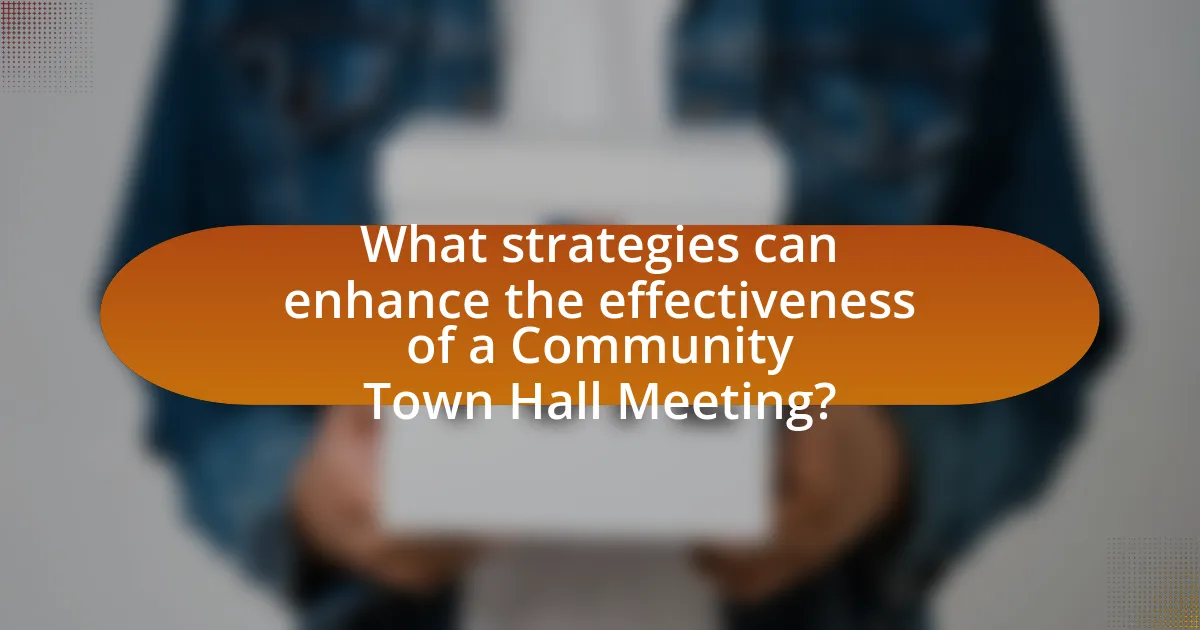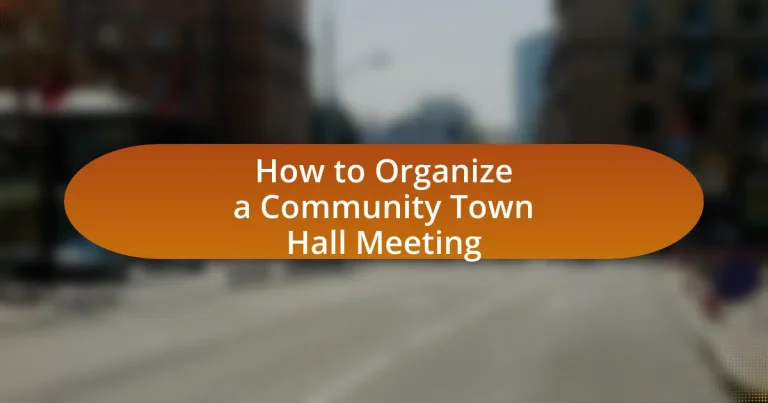A Community Town Hall Meeting is a public forum where residents engage with local officials to discuss community issues, share information, and provide feedback. This article outlines the essential components and functions of such meetings, emphasizing their role in promoting transparency, civic engagement, and effective local governance. It details the steps for organizing a successful meeting, including defining objectives, selecting an accessible venue, promoting the event, and facilitating productive discussions. Additionally, the article highlights best practices for ensuring inclusivity and gathering participant feedback, ultimately aiming to enhance community involvement and influence local decision-making.

What is a Community Town Hall Meeting?
A Community Town Hall Meeting is a public gathering where community members come together to discuss local issues, share information, and engage with elected officials or community leaders. These meetings serve as a platform for residents to voice their concerns, ask questions, and provide feedback on community matters. Historically, town hall meetings have been a cornerstone of democratic engagement, allowing citizens to participate actively in governance and decision-making processes at the local level.
How does a Community Town Hall Meeting function?
A Community Town Hall Meeting functions as a platform for local residents to engage with elected officials and community leaders, facilitating open dialogue on issues affecting the community. During these meetings, participants typically gather in a public space where they can express concerns, ask questions, and provide feedback on local policies or initiatives. The format often includes presentations from officials, followed by a question-and-answer session, allowing for direct interaction between the community and its leaders. This structure promotes transparency and encourages civic participation, which is essential for effective governance and community development.
What are the key components of a Community Town Hall Meeting?
The key components of a Community Town Hall Meeting include a clear agenda, a designated facilitator, an open forum for public input, and a method for documenting feedback. A clear agenda outlines the topics to be discussed, ensuring that the meeting stays focused and productive. The designated facilitator guides the discussion, manages time, and encourages participation from attendees. An open forum allows community members to voice their opinions and concerns, fostering engagement and transparency. Finally, documenting feedback is essential for accountability and follow-up, as it provides a record of community input and decisions made during the meeting. These components collectively enhance the effectiveness of the town hall meeting in addressing community issues.
How do these components contribute to effective communication?
Effective communication in a community town hall meeting is facilitated by components such as clarity, active listening, and structured dialogue. Clarity ensures that messages are easily understood, reducing the likelihood of misinterpretation. Active listening fosters engagement and demonstrates respect for participants’ viewpoints, which enhances trust and collaboration. Structured dialogue, through defined agendas and time management, allows for organized discussions, ensuring that all voices are heard and that the meeting remains focused on key issues. These components collectively create an environment conducive to open and productive exchanges, ultimately leading to informed decision-making and community cohesion.
Why are Community Town Hall Meetings important?
Community Town Hall Meetings are important because they facilitate direct communication between local government officials and community members, fostering transparency and civic engagement. These meetings provide a platform for residents to voice concerns, ask questions, and contribute to decision-making processes that affect their lives. Research indicates that communities with active town hall meetings experience higher levels of public trust in government and increased participation in local initiatives, as evidenced by a study from the International City/County Management Association, which found that 70% of participants felt more informed about local issues after attending such meetings.
What role do they play in community engagement?
They play a crucial role in community engagement by facilitating dialogue between community members and local leaders. This interaction fosters transparency, encourages participation, and builds trust within the community. Town hall meetings serve as a platform for residents to voice concerns, share ideas, and collaborate on solutions, thereby enhancing civic involvement and community cohesion. Research indicates that communities with active engagement through such meetings experience higher levels of satisfaction and trust in local governance, as evidenced by a study from the International City/County Management Association, which found that 75% of participants felt more connected to their community after attending a town hall meeting.
How can they influence local decision-making?
They can influence local decision-making by actively participating in town hall meetings and voicing their concerns or suggestions. This participation allows community members to present their perspectives directly to local officials, fostering dialogue and collaboration. Research indicates that communities with higher engagement in local governance often see more responsive decision-making, as officials are more likely to consider the views of active constituents. For example, a study by the National Civic League found that communities that regularly hold town hall meetings report increased satisfaction with local governance and improved public trust.

What are the steps to organize a Community Town Hall Meeting?
To organize a Community Town Hall Meeting, follow these steps: first, define the purpose and objectives of the meeting to ensure clarity on the topics to be discussed. Next, select a suitable date, time, and location that is accessible to the community, considering factors such as venue capacity and availability. Then, promote the event through various channels, including social media, local newspapers, and community bulletin boards, to maximize attendance. Prepare an agenda outlining the key discussion points and allocate time for each topic, ensuring that community members have the opportunity to voice their opinions. Finally, facilitate the meeting effectively by encouraging participation, managing time, and summarizing key takeaways to ensure that the objectives are met and community feedback is captured.
How do you determine the purpose of the meeting?
To determine the purpose of the meeting, clearly define the objectives you aim to achieve. This involves identifying the key issues or topics that need discussion, such as community concerns, project updates, or feedback collection. For instance, if the goal is to address local infrastructure improvements, the meeting should focus on gathering input from residents about their needs and priorities. Establishing a specific purpose helps in structuring the agenda and ensuring that the meeting remains focused and productive.
What questions should you ask to clarify the meeting’s objectives?
To clarify the meeting’s objectives, ask specific questions such as: “What is the primary goal of this meeting?” This question directly addresses the main purpose and helps participants focus on the intended outcomes. Additionally, inquire, “Who are the key stakeholders involved?” to identify relevant parties and their interests, ensuring that all perspectives are considered. Another important question is, “What decisions need to be made by the end of this meeting?” This question establishes clear expectations for actionable outcomes. Lastly, ask, “What information or resources are required to achieve these objectives?” to ensure that all necessary materials are prepared in advance, facilitating a productive discussion. These questions collectively enhance clarity and focus, leading to a more effective meeting.
How can you align the purpose with community needs?
To align the purpose with community needs, conduct a thorough assessment of the community’s priorities and challenges through surveys, interviews, and public forums. This approach ensures that the objectives of the town hall meeting directly address the specific issues that matter most to the community members. For instance, a study by the International City/County Management Association found that communities with active engagement in identifying their needs are 30% more likely to see successful outcomes in local initiatives. By integrating community feedback into the planning process, organizers can create a relevant agenda that resonates with participants, fostering greater involvement and support.
What logistical considerations are necessary for planning?
Logistical considerations necessary for planning a community town hall meeting include venue selection, scheduling, resource allocation, and communication strategies. Venue selection involves choosing a location that is accessible to the community, has adequate space for attendees, and meets any technical requirements for presentations. Scheduling requires identifying a date and time that accommodates the majority of participants, often considering local events or holidays that may affect attendance. Resource allocation involves determining the necessary materials, such as seating, audio-visual equipment, and refreshments, ensuring that all logistical needs are met. Communication strategies must be developed to effectively promote the meeting, utilizing various channels such as social media, flyers, and community bulletins to reach a broad audience. These considerations are essential for ensuring a successful and well-attended event.
How do you choose an appropriate venue?
To choose an appropriate venue for a community town hall meeting, assess the size, accessibility, and facilities of potential locations. The venue must accommodate the expected number of attendees comfortably, ensuring there is enough space for seating and any necessary equipment. Accessibility is crucial; the venue should be easily reachable by public transport and have provisions for individuals with disabilities. Additionally, consider the availability of essential facilities such as audio-visual equipment, restrooms, and parking. Research indicates that venues that meet these criteria enhance participation and engagement, as seen in studies showing that accessible and well-equipped locations increase attendance rates by up to 30%.
What factors should you consider for scheduling the meeting?
When scheduling a meeting, consider the availability of participants, the purpose of the meeting, and the location. Availability of participants is crucial; ensure that key stakeholders can attend by checking their schedules in advance. The purpose of the meeting should dictate the timing; for instance, if the meeting involves community input, scheduling it during evenings or weekends may increase attendance. The location must be accessible to all participants, factoring in transportation options and any necessary accommodations. These considerations are supported by studies indicating that participant availability and accessibility significantly impact meeting attendance and engagement levels.
How do you promote the Community Town Hall Meeting?
To promote the Community Town Hall Meeting, utilize multiple communication channels such as social media, local newspapers, community bulletin boards, and email newsletters. Engaging with community leaders and organizations can amplify outreach efforts, ensuring that the information reaches a broader audience. For instance, studies show that community engagement through social media can increase attendance by up to 30%, highlighting the effectiveness of digital platforms in reaching residents. Additionally, providing clear details about the meeting’s purpose, date, time, and location in all promotional materials enhances visibility and encourages participation.
What channels are most effective for outreach?
The most effective channels for outreach in organizing a community town hall meeting are social media, email newsletters, and community bulletin boards. Social media platforms like Facebook and Twitter allow for broad engagement and sharing of event details, reaching diverse demographics quickly. Email newsletters provide direct communication to interested parties, ensuring that key information reaches those who are already engaged with the community. Community bulletin boards, both physical and digital, serve as local hubs for information dissemination, targeting residents in specific neighborhoods. These channels have been shown to increase attendance and participation in community events, as evidenced by studies indicating that social media can boost event visibility by up to 80%.
How can you engage community members before the meeting?
To engage community members before the meeting, utilize multiple communication channels such as social media, email newsletters, and community bulletin boards to disseminate information about the meeting. This approach ensures that the message reaches a diverse audience, increasing awareness and participation. Research indicates that effective pre-meeting engagement can boost attendance by up to 30%, as seen in community initiatives that actively promote events through various platforms. Additionally, inviting feedback through surveys or polls prior to the meeting fosters a sense of ownership and encourages members to contribute their ideas, further enhancing engagement.

What strategies can enhance the effectiveness of a Community Town Hall Meeting?
To enhance the effectiveness of a Community Town Hall Meeting, organizers should implement strategies such as clear agenda setting, active facilitation, and inclusive participation. Clear agenda setting ensures that all participants understand the topics to be discussed, which can lead to more focused and productive conversations. Active facilitation by a skilled moderator helps manage discussions, encourages diverse viewpoints, and keeps the meeting on track. Inclusive participation can be achieved by promoting accessibility and encouraging input from all community members, which fosters a sense of ownership and engagement. Research indicates that meetings with structured agendas and active facilitation result in higher satisfaction and engagement levels among participants, as evidenced by a study published in the Journal of Community Engagement and Scholarship, which found that well-organized meetings lead to more effective community outcomes.
How can you facilitate productive discussions during the meeting?
To facilitate productive discussions during the meeting, establish clear objectives and guidelines beforehand. Setting specific goals helps participants understand the purpose of the discussion, which can lead to more focused and relevant contributions. Research indicates that meetings with defined objectives are 30% more effective in achieving desired outcomes. Additionally, encouraging active participation by inviting diverse viewpoints fosters a collaborative environment, enhancing the quality of the dialogue. Implementing structured formats, such as round-robin sharing or breakout groups, can also ensure that all voices are heard, further promoting engagement and productivity.
What techniques can encourage participation from attendees?
To encourage participation from attendees, interactive techniques such as polls, Q&A sessions, and small group discussions can be implemented. These methods actively engage participants, making them feel valued and heard. For instance, research shows that events incorporating audience polling can increase engagement by up to 30%, as attendees are more likely to contribute when they see their opinions reflected in real-time results. Additionally, facilitating small group discussions allows for more intimate conversations, fostering a sense of community and encouraging quieter individuals to share their thoughts.
How do you manage differing opinions and conflicts?
To manage differing opinions and conflicts during a community town hall meeting, establish clear communication guidelines and encourage respectful dialogue. This approach fosters an environment where participants feel safe to express their views while minimizing escalation. Research indicates that structured facilitation techniques, such as active listening and summarizing points of agreement and disagreement, can effectively de-escalate tensions and promote understanding among diverse perspectives. For instance, a study by the National Civic League highlights that communities employing these techniques report higher satisfaction with conflict resolution processes.
What follow-up actions are essential after the meeting?
Essential follow-up actions after the meeting include sending a summary of the meeting minutes to all participants, addressing any unresolved questions, and outlining the next steps. Sending meeting minutes ensures that all attendees have a clear record of discussions and decisions made, which is crucial for accountability and transparency. Addressing unresolved questions demonstrates responsiveness and commitment to participant concerns, fostering trust within the community. Outlining next steps provides a clear action plan, guiding participants on what to expect moving forward and encouraging continued engagement.
How can you gather feedback from participants?
To gather feedback from participants, utilize surveys and questionnaires immediately following the event. These tools allow for structured responses and can be distributed both in paper form and electronically, ensuring accessibility. Research shows that post-event surveys can yield a response rate of up to 30%, providing valuable insights into participant experiences and suggestions for improvement. Additionally, conducting follow-up interviews or focus groups can deepen understanding of participant perspectives, as qualitative data often reveals nuances that surveys may miss.
What steps should you take to implement community suggestions?
To implement community suggestions, first, gather and categorize the suggestions received during the town hall meeting. This step ensures that all feedback is organized for further analysis. Next, prioritize the suggestions based on feasibility, impact, and community interest, which allows for effective resource allocation. After prioritization, develop an action plan that outlines specific steps, timelines, and responsible parties for each suggestion. Finally, communicate the outcomes and progress back to the community to maintain transparency and encourage ongoing engagement. This structured approach is supported by community engagement best practices, which emphasize the importance of feedback loops in fostering trust and collaboration.
What are some best practices for organizing a successful Community Town Hall Meeting?
To organize a successful Community Town Hall Meeting, it is essential to establish a clear agenda that addresses community concerns and encourages participation. This involves identifying key topics through surveys or community feedback, ensuring that the meeting is relevant and engaging for attendees. Additionally, selecting an accessible venue and promoting the event through various channels, such as social media and local newsletters, increases attendance and community involvement.
Furthermore, appointing a skilled moderator helps facilitate discussions, manage time effectively, and ensure that all voices are heard. Providing opportunities for questions and feedback during the meeting fosters a sense of community ownership and transparency. Lastly, following up with attendees post-meeting through summaries or action plans demonstrates accountability and keeps the community informed about the outcomes and next steps. These practices are supported by research indicating that well-organized town hall meetings lead to higher community engagement and satisfaction.
How can you ensure inclusivity and accessibility for all community members?
To ensure inclusivity and accessibility for all community members, implement universal design principles in the planning and execution of events. This includes providing materials in multiple formats, ensuring physical spaces are wheelchair accessible, and offering language translation services. Research indicates that events designed with inclusivity in mind can increase participation by up to 30%, as demonstrated in studies conducted by the National Council on Disability.
What common pitfalls should you avoid during the planning process?
Common pitfalls to avoid during the planning process of a community town hall meeting include inadequate stakeholder engagement, lack of clear objectives, and poor time management. Inadequate stakeholder engagement can lead to low attendance and participation, as failing to involve key community members may result in a lack of interest or support. Lack of clear objectives can cause confusion about the meeting’s purpose, making it difficult to achieve desired outcomes. Poor time management can lead to rushed discussions or incomplete agendas, ultimately diminishing the effectiveness of the meeting. These pitfalls are supported by studies indicating that successful community meetings require active participation, clear goals, and structured timelines to foster productive dialogue and decision-making.


